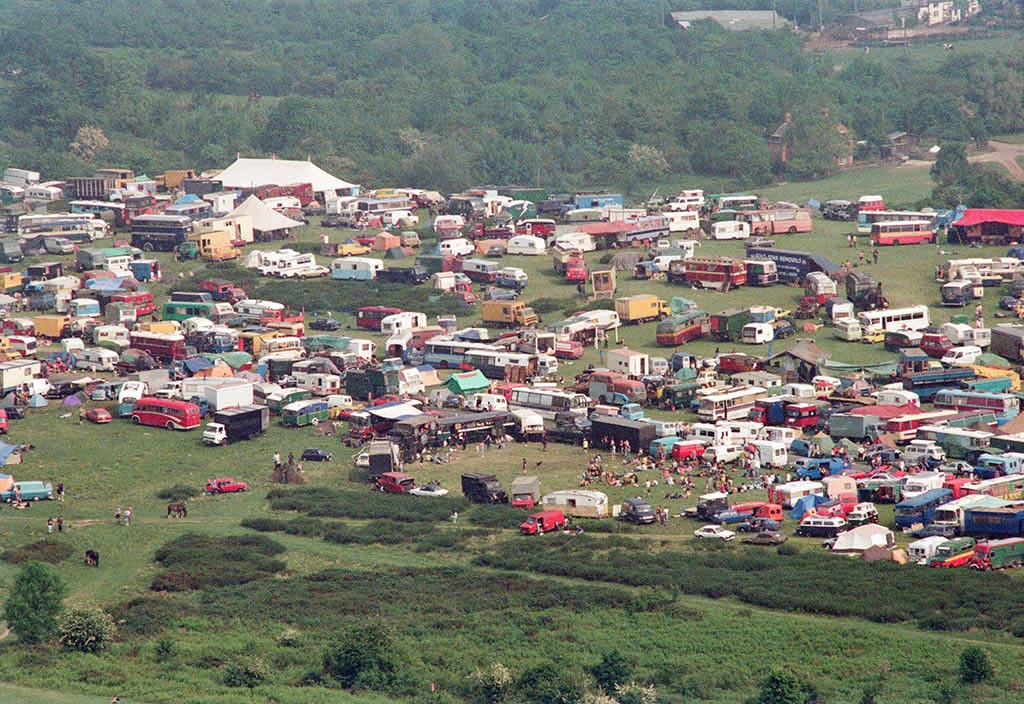Journalist Emma Warren interviews Ian Mitchell, who contributed to Dorothy’s Acid House Love Blueprint about his memories of attending Castlemorton free festival in 1992.
This article is part of Dorothy's Studio Stories series.
30 YEARS SINCE CASTLEMORTON
−Interview with Ian Mitchell by Emma Warren
Ian Mitchell had been going to free parties for a year when he and his friends heard that DIY Soundsystem had plans for the bank holiday weekend ‘somewhere in the south west’. He tells Emma Warren how they ended up at the first night of the huge Castlemorton free party. It went on for a week – between May 22nd and 29th, 1992 – a high point that signalled the end of an era and which contributed to 1994’s Criminal Justice Act, which outlawed unlicensed dancing to repetitive beats.

Castlemorton 1992: Image used with kind permission - Alan Lodge
How did you find free parties in the year before Castlemorton?
It was through friends at Bath College. A year before, there was the Avon Free Festival, which was an old traveller’s free festival, the first big one of the season. It was gradually getting less about bands like [psychedelic rockers] Hawkwind and had been infiltrated by house music. Word got out that there was a free party somewhere. I drove to Bath, we went into a pub, hung around til someone told us where to go, then ended up driving north of Bristol, to Chipping Sodbury. There were a couple of marquees. It was a pretty amazing night.
What do you remember?
The details are hazy. You had a load of young people dressed similarly, the fashion of the day, alongside the travellers. The travellers had organised everything, they were looking after the tech and the equipment. Someone was going round with a bucket to get more petrol for the generator.
Can you remember anything about the feeling in your body? Is it packed, is it sweaty?
There was a space to it, which I really liked. When you’re moving about and dancing there’s that thud. A different kind of sound, because it’s grass you’re dancing on, sweatshirt would be around your waist. There were peak experiences involved, you can’t ignore that. It felt much nicer to be indulging in that in a place where you could find space.
A year later you’re at Castlemorton. What happened in-between?
From that point on until the end of September every weekend we were finding somewhere. I had a holiday in the middle of it – ‘my god, why am I going on holiday?’ – missing what was going on. I’d heard about a free festival up here in Birkenhead at Moreton Lighthouse. When I got back off holiday, my friends were like ‘we went to this thing up in Liverpool and it was mad and a bit scary.’ Then I read this I just read this [pulls out Harry Harrison’s ‘Dreaming In Yellow: The Story of the DIY Soundsystem’] and I was like ‘OK! I understand!’
Do you remember hearing about Castlemorton before it happened?
There was definitely an expectation that something would happen that weekend. We heard that DIY were doing something in the south west, bank holiday weekend. Me and my mate drove down to Bristol. I think we spent a lot of time sitting round in someone’s flat waiting for the word to come through.
Richard King wrote about Castlemorton in The Lark Ascending. He remembered queuing in traffic, and the stench, because of ravers not being familiar with how travellers managed without toilets – which involved using a shovel. What do you remember about arriving there?
I remember skirting round Worcester, looking for the sign to Castlemorton. I remember us getting quite close to the common, cars parked up, meaning it’s time to ditch the car and walk the rest of the way. I jumped out of the car and immediately felt really at home and super-confident, which was unusual. There was a policeman right in front of me and I bounced up, all happy and asked ‘which direction is it?' The policeman looked at me [puts on quizzical voice] and was like, ‘Up there, take a left, but why don’t you just go home?’
What did you find up there?
It was huge. It was a different scale to what I’d experienced before. There was a gravel track that went across the common and every 50 yards or so there was a marquee and a different soundsystem. There must have been eight or nine. The first one on the right hand side might have been Spiral Tribe. We skirted that, it wasn’t quite our scene. We headed for the DIY tent which was at the other end of the track. I remember sitting on the hill when the sun had come up. It was an amazing day. The weather was brilliant. Looking around, thinking ‘What the hell? This is bonkers’. Linking back to Richard King’s story, I distinctly remember hearing a more experienced traveller pleading with people to go and ask a traveller for a spade, so they could deal with what they were doing in the woods. It was a moment of realisation: ‘oh yeah’. Back in the tent I remember it being daylight and hearing Young MC’s ‘I Come Off’ but a particular mix that samples Aaron Neville’s ‘Hercules’ [Dave Dorrell and CJ Mackintosh’s Southern Comfort version]. It revitalised things at that time in the morning.
How long did you stay for?
Until about midday on the Saturday. Nature was calling, we didn’t have much money left, we wanted some food. I remember us walking back, and asking a traveller - how did you find these spaces? He gave me a quick introduction to the rights of the common man to use common land in England. I don’t know the veracity of all that and it probably doesn’t exist any more, given what happened afterwards. We drove to Manchester to get our friends to come back Saturday night – although that didn’t happen.
You’d spent pretty much a year going to free parties and clubs very regularly. The repetition, the going out week by week was important, wasn’t it?
Yes, but I was dropping into it on a weekly basis. The people who were organising it were living on these sites, moving on from place to place. For a sweet period everyone was cool with that. There was quite an alliance going on. Travellers, convoys were already under threat. In hindsight you wonder how much attention the city ravers ended up shining a light on that lifestyle.
Back to Castlemorton. I remember the aerial footage on the news. Do you remember helicopters?
I don’t know if the helicopters were there when I was there. It went on for four or five days, the sun was shining, they were locked in so to say. Weirdly, those images are also a way I remember it.
In the way photography can overlay your own memories of things. At the time did you have a sense of being somewhere iconic?
Yes, I think so. The year before, that felt like being at the vanguard of something. Quite quickly it was like ‘this might be too big’.
Certainly the state believed so…
That chat I had with the traveller as I was leaving, it felt really positive, it felt like a revolutionary statement within the parameters of what a party can be.
The government definitely perceived it like that. What do you think about it now?
[pauses for quite a long time]. I’m glad I was there. In hindsight, it’s a shame it finished off that scene for me and for a lot of others. The previous year holds my memories really. Castlemorton signifies the end of that. It’s slightly bittersweet.
Ian Mitchell is Senior Lecturer in Graphic Design and Illustration at Liverpool John Moore’s and contributed to Dorothy’s Acid House Love Blueprint and the Blackburn Parties Blueprint.
Emma Warren is a Journalist and an Author.

